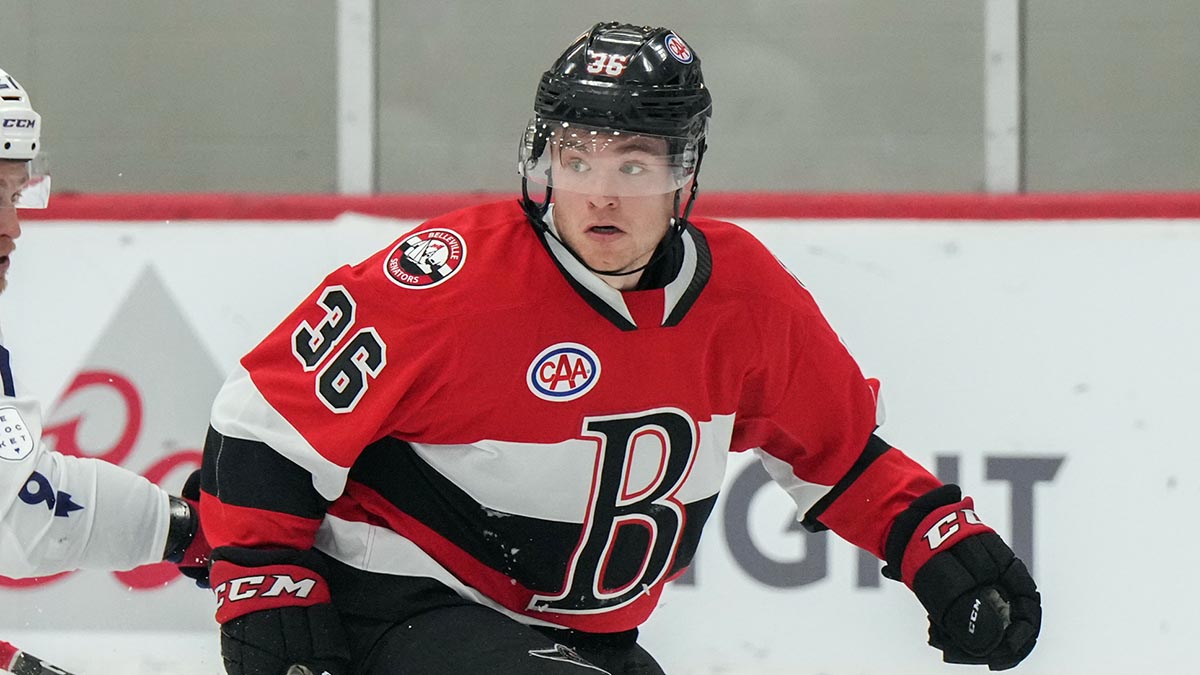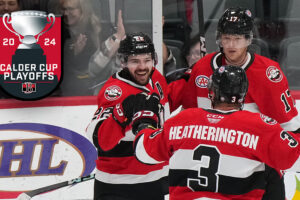📝 by Patrick Williams
More than one path to the National Hockey League exists, a message that Belleville Senators interim head coach David Bell constantly works to impress upon his young prospects.
Take forward Angus Crookshank, whose team-leading 25 goals tie him for third among AHL rookies. An ability to produce offensively has brought him to within one step of the NHL.
But will it take him that one final step, the most difficult one of all?
“I don’t mean any disrespect to Angus Crookshank,” Bell said, “but he’s not a top-six in the NHL, and I think he’s recognizing that. He can be a middle-six and a bottom-six, but those guys don’t get the leeway defensively that those top-six elite get in the NHL.
“I think that’s the problem. Guys think they’re really good, but you can be really good in the American Hockey League and you’re still not top-six in the NHL, because that’s just how good those guys are. When guys figure that out, and they round out their game, get better on the walls, get better on the face-offs… Then they’ll find a hole in the middle-six and maybe work their way up.”
Crookshank has bought that message, while also making up for plenty of lost time.
Coming out of the University of New Hampshire late in the shortened 2020-21 season, Crookshank made a quick adjustment to the pro game with Belleville, squeezing 19 games into a six-week stint with the B-Sens. A scorer by nature coming out of the college game, Crookshank produced five goals and 16 points, and after a solid summer of training he headed off to prospect camp in Ottawa.
But then a severe knee injury suffered during a prospects game in September 2021 cost Crookshank his entire 2021-22 season.
While the injury kept Crookshank off the ice for months, the 5-foot-11, 185-pound forward still could work on improving his upper-body strength. The result has been noticeable in his being able to protect the puck and fend off opposing defenders, a necessary asset for someone whose game relies on being able to control difficult areas of the ice.
Amid a lineup beset by injuries and personnel losses to Ottawa, Crookshank has been relied on heavily in Belleville this season. His 44 points tie him with Cole Cassels for third in team scoring, and he has proven to be more than durable, missing just one game all season.
For all of Crookshank’s production, though, Belleville is working on what may be a redefined role for him at the NHL level.
“Being an offensive guy, I’ve had to learn how to really round out my 200-foot game and that was a struggle for me to start this season,” Crookshank said. “But since Christmas or so, it’s been a lot better, and I think I’ve started becoming a more complete player because of that. The coaches have done a great job helping me out with that.”
Crookshank also admits that he never particularly needed to develop a robust two-way game. In college, his job description meant scoring.
“Once you get to pro, everybody was a top guy wherever they came from,” he continued. “So not every night you’re going to put up two, three points. (Belleville assistant coach) Ben Sexton calls it a ‘B game,’ so to speak. You may not put anything up on the scoresheet, but you’re sound defensively, you’re structurally good, you’re hard to play against, you’re facing your checks, all that sort of stuff.
“You can still have a good game without producing points, which was kind of an odd concept for me to wrap my head around at first.”
Said Bell, “He knew that he needed to work on his D-zone coverage and work on his 200-foot game. He works every day with video. Now you’re starting to see this guy grow. I can put him out in the last minute or I can put him out with the lead, and he’s going to be responsible.
“That’s where I’ve seen the biggest growth in Angus, and he needs to have that growth to take the next jump.”
TheAHL.com features writer Patrick Williams has been on the American Hockey League beat for nearly two decades for outlets including NHL.com, Sportsnet, TSN, The Hockey News, SiriusXM NHL Network Radio and SLAM! Sports, and was most recently the co-host of The Hockey News On The ‘A’ podcast. He was the recipient of the AHL’s James H. Ellery Memorial Award for his outstanding coverage of the league in 2016.






































